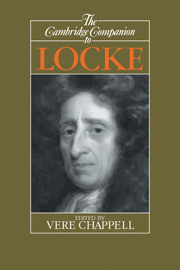Book contents
- Frontmatter
- Introduction
- 1 Locke's life and times
- 2 Locke's theory of ideas
- 3 Locke's philosophy of body
- 4 Locke's philosophy of mind
- 5 Locke's philosophy of language
- 6 Locke's theory of knowledge
- 7 Locke's philosophy of religion
- 8 Locke's moral philosophy
- 9 Locke's political philosophy
- 10 Locke's influence
- Bibliography
- Index
9 - Locke's political philosophy
Published online by Cambridge University Press: 28 May 2006
- Frontmatter
- Introduction
- 1 Locke's life and times
- 2 Locke's theory of ideas
- 3 Locke's philosophy of body
- 4 Locke's philosophy of mind
- 5 Locke's philosophy of language
- 6 Locke's theory of knowledge
- 7 Locke's philosophy of religion
- 8 Locke's moral philosophy
- 9 Locke's political philosophy
- 10 Locke's influence
- Bibliography
- Index
Summary
Locke's political philosophy has generally been presented and assessed in terms of certain conclusions drawn from a few basic premises. Since Locke's political theory was not constructed according to the presuppositions of analytical philosophy, such an interpretive approach to his political thought seems better designed to portray Locke as an inconsistent or unclear thinker than to provide the reader of the Two Treatises of Government with an understanding of what Locke was attempting to do in writing that work.
I propose in this essay to follow another interpretive path by beginning with Locke's conclusion, namely, that “it is lawful for the people . . . to resist their King” (T II.xix.232: 437), and ask how and why did he come to that conclusion? If, as I shall argue, it was part of Locke’s intentional objective in writing the Two Treatises to persuade his readers that they should resist the king, then putting the question in this form will assign considerable importance to determining the relationship between political theorizing and engagement in political actions.
- Type
- Chapter
- Information
- The Cambridge Companion to Locke , pp. 226 - 251Publisher: Cambridge University PressPrint publication year: 1994
- 16
- Cited by

